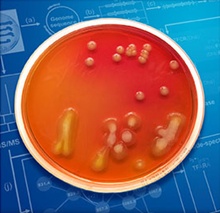Researchers translate the chemical language of microbes
31 Jul 2014
In the environment, microbes often communicate with each other using small molecules.
Ribosomally synthesised and post-translationally modified peptides produced by microbes represent a class of metabolites that are ecologically important and potentially involved in microbial communication.
 Currently, there is a need for more automated computational tools that not only predict outcomes based on microbial genome sequences, but also connect that information to knowledge about the chemical properties of microbial metabolites.
Currently, there is a need for more automated computational tools that not only predict outcomes based on microbial genome sequences, but also connect that information to knowledge about the chemical properties of microbial metabolites.
This study introduces the first genome-mining tool that automates both the prediction and connection steps for modified-peptide discovery.
The new open-access genome-mining tool, known as RiPPquest, can search mass spectrometry databases to identify and discover these microbial peptides. By combining genomics and proteomics, the automated computational tool will help scientists translate the chemical language of microbes into biological function.
Researchers from the Department of Energy's Pacific Northwest National Laboratory and the University of California, San Diego, used microbial genome sequence data to develop a database of predicted lanthipeptides - a group of modified peptides widely distributed among bacterial genomes.
They then connected information from this database to mass spectrometry data sets containing information about the mass and chemical structure of metabolites from bacterial extracts.
Using the mass spectrometry data, the researchers generated molecular networks to visualise related peptides and discover uncharacterised variants of known lanthipeptides, including less abundant variants other methods fail to capture. A portion of this research was performed using high-resolution mass spectrometry resources at EMSL, the Environmental Molecular Sciences Laboratory, a DOE national scientific user facility.
The researchers tested their RiPPquest approach-the first genome-mining algorithm for modified-peptide discovery - by applying it to 16 genome-sequenced bacterial strains and identifying six known lanthipeptide families.
Moreover, RiPPquest revealed a new peptide named informatipeptin, illustrating the power of this algorithm for discovering natural products. Unlike other currently available tools that search mass spectrometry databases, RiPPquest enables the discovery of peptides that are extensively modified after being created by cellular structures called ribosomes.
Beyond lanthipeptides, the algorithm can be used to characterise other types of secondary metabolites.
This research was supported by the US National Institutes of Health.






























